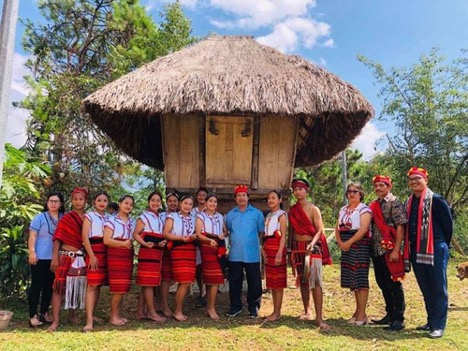
BY LEANDER C. DOMINGO
IFUGAO (June 9)—A cultural exhibit at the Ifugao State University (IFSU)-Hapao Campus’ Indigenous Peoples Resource Conservation and Community Learning Center showed photos of native houses and their narratives, and orientations on cultural items and indigenous cuisine.
According to Faith Napudo, IFSU administrative officer, the cultural exhibit dubbed “Pangipaptok hi Nunhituwan: The Built Heritage of Hungduan” was to give honor to Heritage Month on May 26.
As a stimulus for enhancing cultural awareness and appreciation, Napudo said the event highlighted the Ifugao native house, the most tangible symbol of Ifugao culture.
Representing IFSU President Dr. Eva Marie Codamon-Dugyon, Dr. Marissa Bulong, IFSU vice president for Research Development, Extension and Training, said “conservation initiatives made alive through exhibits are critical in meeting the vision of conserving their heritage.
“Over the last decades, we have witnessed the disappearance and deterioration of our built heritage. Traditional house construction is a dying art with fewer and fewer master builders in the communities,” she said.
Napudo said the exhibit is also part of the “Ruritage: Heritage for Rural Regeneration” project as an additional replicator, explaining that Ruritage turns rural areas into laboratories to demonstrate cultural and natural heritage as an engine of regeneration.
She said Dr. Consuelo Habito of the University of the Philippines Open University (UPOU), also led the ceremonial toasting for rural regeneration through Ifugao house heritage.
In her elaboration on the assessment of Ifugao house conservation, Eulalie Dulnuan, National Museum-Cordillera supervising administrative officer, noted that in Kiangan town in Ifugao, majority of 207 accounted traditional houses in 13 barangays are used for granary or storage.
“There is a need for Ifugao residents to preserve these houses, some of which are 99 and 100 years old, to protect the rich heritage of the native Ifugao house,” Dulnuan said.
Sharing her insights on how houses carried stories and the history of the place, Regina Guimpatan, Campus Chairperson for Museum, cited two of the native houses in the displayed photos which made her recall her childhood.
“The house of Apu (elder) Tapo and Apu Binnowuk was then called ‘The House of Bumayah,’ for many years during their time, ‘Bimmayah bayah da,’ but I have never attended one. I knew there were pigs butchered, wine being served and baki (ritual) being done,” Guimpatan said.
“I could only recall those successive nights when people danced with the rhythm of the gongs. The gong beaters sit around under the house,” she said.
Napudo also noted that based on a research “(Con)serving Indigenous Cuisines” by Clyde Sam Pumihic, an Ifugao Satoyama Meister Training Program alumnus, it was recommended that food tourism is a way of restoring the resources or ingredients that are diminishing to be restored and propagated.
“Food tourism may provide revenue to farmers and tourism operators while conserving our natural heritage,” Pumihic said.
Napudo also said the Hungduan National High School also showcased some Ifugao cultural arts and crafts and how these should be worn or used.
She said Dr. Jose Daniels, Campus Executive Director, believes that IFSU will soon be one of the sought-after museums because of the support it gets from local government units, the UPOU, and the skills training on indigenous practices being offered.
The event was organized with the Ifugao Rice Terraces-Globally Important Agricultural Heritage Systems Center headed by Judy Baggo, IFSU-Hapao Campus, UPOU and the local government of Hungduan.
